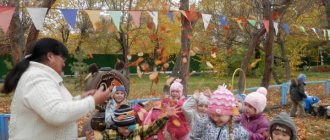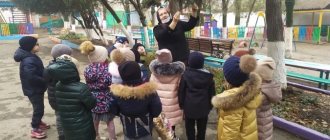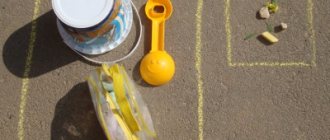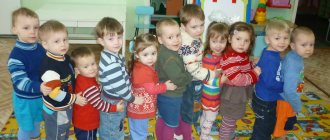Card index of walks. First junior group. Spring.card file (junior group) on the topic
- Card index of walks. First junior group. Spring.
March
Walk 1
Observing snow - continue to introduce children to natural phenomena - snow. How did the snow turn out? Why are the paths slippery? How should you walk along the paths? Form basic ideas about weather changes.
The outdoor game “Hares and the Wolf” - practice jumping in place and moving forward.
Didactic game “One - Many” - teach to distinguish the number of objects.
Work. Clearing buildings of snow - involve in carrying out assignments.
Individual work. Game exercise “Find the Katya doll” - exercise orientation in space.
Walk 2
Observing the sky - teach to distinguish the states of the sky: cloudy, clear.
The outdoor game “The white bunny washes itself” is to teach children to listen to the text and perform movements in accordance with the content.
Didactic game “Compare pieces of ice by size” - learn to determine the size of objects (large - small).
Work. We collect pieces of ice in a bucket - teach how to carry out simple tasks.
Individual work. Repetition of verses for March 8.
Walk 3
Watching the snow. Experimentation: “Snow melts on the palm of your hand” - continue to consolidate ideas about the properties of snow.
The outdoor game “Catch up with me” is to practice running in a certain direction.
Didactic game “Define the color of clothes” - teach to distinguish primary colors.
Work. Let's clear the benches of snow - run errands.
Individual work. Jumping forward.
Walk 4
Observation of the wind - involve children in observing natural phenomena, diversify children's play activities through games with plumes.
Outdoor game “The Most Accurate” - practice throwing snowballs at a target.
Didactic game with colored ice floes: “Arrange the ice floes by color” - consolidate knowledge of primary colors.
Work. “Let’s sweep the path” - involve in carrying out assignments.
Individual work. Jumping on two legs.
Walk 5
Observation of transport - fix the name of the parts of the car (body, cabin, wheels, steering wheel).
The outdoor game “We are drivers” is to teach how to navigate the terrain.
Didactic game “Guess by Description” - learn to guess a pet by description.
Work. Construction of a highway from snow - teach to work together, help each other.
Individual work. Throwing snowballs at a distance.
Walk 6
Bird watching - to develop a caring attitude towards birds.
The outdoor game “Crows and the Dog” is to teach how to act on a signal and imitate the movements of birds.
Didactic game “Guess by Description” - learn to guess the inhabitants of the forest by description.
Work. Feeding birds - learning to care for birds.
Individual work. Climbing a gymnastic wall.
Walk 7
Observation “Footprints in the snow” - develop children’s cognitive activity, teach them to identify the identity of footprints: children’s, adults, birds, animals.
The outdoor game “Run to what I name” is to teach how to navigate in space, to remind children of the names of objects.
Didactic game “What am I doing?” - intensify the use of verbs in speech.
Work. Shovel snow - learn to work together.
Individual work. Run in different directions.
Walk 8
Observing the weather of the day. What changed? How did the sun begin to shine? Draw the children's attention to the appearance of icicles, explain that the sun warms the snow, it melts, flows off the roof, forming icicles. Form ideas about spring changes in nature.
Outdoor game “Airplanes” - practice performing actions on a signal.
Didactic game “Small and large icicles” - teach to distinguish objects by size.
Labor Clearing snow around buildings - involve them in joint labor.
Individual work. Remember the poem "Mother's Day."
Walk 9
Observing the work of a janitor is to continue to introduce adults to the work and create a desire to help.
Work. Helping a janitor clear the area of snow is to cultivate a desire to work.
Outdoor game “Birds, one!” Birds, two! — exercise children in performing movements, teach counting.
Didactic exercise “Who does what?” — clarify children’s ideas about the work of adults.
Individual work. Writing the story “How we helped the janitor”
Walk 10
Observation of transport - familiarize children with vehicles in their immediate environment.
The outdoor game “Sparrows and a Car” is to exercise the ability to run in different directions without bumping into each other, the ability to start moving and change it at a signal, and find your place.
Didactic game “Match scoops to buckets” - learn to determine the color of an object, find objects of the same color.
Work. Sweeping snow from paths - running errands.
Individual work. Game exercise “I’ll draw in the snow...”
Walk 11
Observing passers-by and their clothes - to activate the vocabulary on the topic “Clothing”.
The outdoor game “Ladushki - pancakes” - teach children to clap their hands in different ways; count “One-two.”
Didactic game “Arrange the flags by color” - teach to distinguish colors.
Work. “Let’s collect the snow in a pile and build a slide for Katya’s doll” - get children interested in completing work assignments.
Individual work. Game exercise “Along a narrow path.”
Walk 12
Observing the weather of the day - draw children's attention to puddles on the roads, drops from roofs - to form ideas about spring changes in nature.
The outdoor game “Airplanes” is to exercise the ability to run without bumping into each other, and to perform movements on a signal.
Didactic game “What color?” - consolidate knowledge of primary colors.
Work. We carry snow in buckets to a certain place - to cultivate the desire to work together.
Individual work. Walking on a straight path.
Walk 13
Observation of transport - to form ideas about the diversity of transport.
The outdoor game “Cars” teaches how to navigate in space, run without bumping into each other.
Didactic exercise “What color are cars?” - consolidate knowledge of colors.
Work. Construction of a highway - learn to build together.
Individual work. Onomatopoeia exercise “How does a car honk?”
Walk 14
Observing the wind, playing with pinwheels - during games, introduce an accessible natural phenomenon - the wind.
The outdoor game “Legs” is to teach how to act according to the text.
Didactic game “Guess who called” - to develop auditory attention.
Work. Feeding birds – continue to foster a desire to care for birds.
Individual work. Finger gymnastics “Castle”
Walk 15
Observation “The sun is warming up” - to give children their first ideas about spring.
Outdoor game “Mice dance in a round dance” - practice performing movements.
Didactic game “Light - Heavy” - learn to determine with closed eyes how much snow is in a bucket.
Work. Clearing the path of snow will make you want to work together with the teacher.
Individual work. Repeat the nursery rhyme “Egorka the Hare”
April
Walk 1
Observation “There is water all around” - show children a variety of actions with melted snow.
The outdoor game “Through the Stream” is to develop dexterity, a sense of balance, and an eye.
Didactic game “Small and large streams” - teach to distinguish streams by size.
Work. Collecting twigs - to cultivate a desire to carry out assignments. We let the branches float through the water and see if they sink or float.
Individual work. Finger gymnastics “Home”.
Walk 2
Observing the buds on trees - attract children to observe objects of wildlife, cultivate a caring attitude towards trees.
The outdoor game “Train Locomotive” is to teach how to move at different paces, change direction, convey the characteristic movements of animals and birds; practice pronouncing sounds.
The didactic game “Guess what to do” is to develop the ability to switch auditory attention, the ability to correlate one’s actions with the sound of a tambourine.
Work. Let's sweep the gazebo - carry out simple tasks.
Individual work. Repeat the nursery rhyme “Egorka the Hare”
Walk 3
Observing the work of a janitor - to cultivate interest in the work of adults, to intensify the use of verbs in speech.
Outdoor game “Across the Stream” - jumping on two legs.
Didactic game “Vegetable shop” - learn to name vegetables correctly.
Work. Let's remove branches from the area - support the desire to help adults.
Individual work. Remember the nursery rhyme “The cat went to market.”
Walk 4
Observation of the wind - attract children to observe accessible natural phenomena, promote the development of play activities, motor activity through games with plumes.
The outdoor game “The little gray bunny is sitting” - teach how to perform movements in accordance with the text.
Didactic game “One - Many” - consolidate the ability to distinguish the number of objects.
Work. Let's sweep in the gazebo - involve them in carrying out work assignments.
Individual work. “Catch the ball” - practice catching the ball.
Walk 5
Watching an airplane in the sky helps to develop interest in the world around us and tell children about the profession of a pilot.
Outdoor game “Airplanes” - practice performing movements on a signal.
Didactic game “Who and where?” — learn to navigate in space, improve understanding of adult speech.
Work. We help the janitor to cultivate a desire to help adults.
Individual work. Jumping over the line.
Walk 6
Observation of rain - to form elementary ideas about spring changes in nature, to introduce accessible natural phenomena.
Outdoor game “Bubble” - teach how to perform movements in accordance with the text, strengthen the ability to stand in a circle.
Didactic game “Big and Small” - to develop the ability to distinguish objects by size.
Work. Sweep the gazebo - cultivate a desire to keep the gazebo clean.
Individual work. Repeat the nursery rhyme “A fox with a box ran through the forest.”
Walk 7
Observing the weather - forming ideas about spring changes in nature, cultivating interest in the environment.
The outdoor game “Shaggy Dog” is to teach children to act on a signal, to run in different directions without bumping into each other.
Didactic game “Long and short sticks” - learn to distinguish sticks by length.
Work. Let's collect sticks - run errands.
Individual work. Finger gymnastics “Finger – boy”.
Walk 8
Observing the wind - to develop an interest in observing natural phenomena.
Outdoor game “Legs - legs” - teach to act according to the text.
Didactic game “Big and small buckets” - teach to distinguish the size of objects.
Work. Feeding birds – maintaining the desire to care for birds.
Individual work. Repeat A. Brodsky’s poem “Sunny Bunnies”
Walk 9
Observing the melting of snow - attract children to observe accessible natural phenomena, develop thinking and speech.
The outdoor game “At the Bear in the Forest” is to develop interest in Russian folk games, teach to act on a signal.
Didactic game “On our site” - teach how to navigate the kindergarten site, name familiar objects correctly.
Work. Sweep the central path - involve him in carrying out assignments.
Individual work. Repeat the nursery rhyme “Big feet walked along the road.”
Walk 10
Bird watching - draw children's attention to changes in the behavior of birds: they chirp joyfully, fly in a flock, bask in the sun - develop interest in bird watching, note the changes occurring in nature associated with spring.
The outdoor game “Birds in Nests” teaches you to run in different directions and run into nests when given a signal.
Didactic game “Find out by touch” - learn to identify objects by touch, develop tactile sensations and speech.
Work. Collecting twigs is to involve children in joint work.
Individual work. “Catch and throw” - develop the ability to throw and catch the ball.
Walk 11
Observation of streams - to involve in observations of natural phenomena, to develop the play activity of children through games with boats.
The outdoor game “Catch Me” is to teach you to run in a certain direction.
Didactic game “Drowning does not sink” - to introduce the properties of objects and develop speech.
Work. We collect pebbles on the site - involve them in carrying out assignments.
Individual work. Repeat the poem “The Ship” by A. Barto.
Walk 12
Watching puddles. Compare where there are more puddles - on the asphalt or on the ground. Involve children in observing natural phenomena, develop speech and thinking.
The outdoor game “Crows and the Dog” - learn to imitate the movements and voices of birds, practice running on a signal.
Didactic game “Recognize by sound” - develop auditory attention.
Work. Feeding birds – encourages children to care for birds.
Individual work. Throwing at a target.
Walk 13
Observing the first grass helps to form ideas about spring and develop interest in the world around us.
The outdoor game “Cat and Mice” - continue to attract children to participate in round dance games, develop the ability to listen to the teacher.
Didactic game “Bring the same object” - learn to find among the proposed objects the same one that the teacher showed.
Work. Let's sweep the central path - to cultivate a desire to maintain order in the kindergarten territory.
Individual work. Game exercise “Along a narrow path.”
Walk 14
Observing the sky - cultivate a desire to admire the beauty of the sky.
The outdoor game “Shaggy Dog” is to teach children to run in different directions without bumping into each other.
Didactic game “Select by color” - teach to distinguish primary colors, select objects by color.
Work. We collect twigs - to invite people to participate in joint work.
Individual work. Jumping forward.
Walk 15
Observing the buds - to form elementary ideas about spring changes in nature, to teach how to treat the plant world with care.
Outdoor game “One, two, three – catch!” - learn to run when the teacher gives a signal.
Didactic game “Fox, dance!” - learn to distinguish the sounds of musical instruments by ear.
Work. We are building a house for a doll - to involve in joint construction.
Individual work. Practice catching and throwing a ball.
May
Walk 1
Observing the sun: it shines brightly, warms up, this makes the grass grow, the birds rejoice, the buds bloom - to evoke a joyful spring mood, to form ideas about the signs of spring.
The outdoor game “Sunshine and Rain” - teach how to act on a signal.
Didactic game “Warm - Cold” - develop tactile sensations, show that objects are cold in the shade, and warm in the sun.
Work. Sweep the gazebo - support the desire to work.
Individual work. Throwing a ball at a distance.
Walk 2
Observation of trees - draw children's attention to the blossoming buds, cultivate a caring attitude towards trees.
The outdoor game “Legs” is to teach how to act according to the text of the poem.
Didactic game “Cow, give me some milk” - to improve the intonation expressiveness of speech.
Work. Let's mark the sides of the sandbox - run errands.
Individual work. Learn to answer the questions: “Who? What? What is he doing?"
Walk 3
Watching sparrows: basking, chirping cheerfully, swimming in a puddle - attract to bird watching.
Outdoor game “Get the ball” - practice jumping.
Didactic game “Vegetable Store” - teach to distinguish vegetables and name them correctly.
Work. Loosening the soil in a flowerbed means engaging in labor.
Individual work. Climbing on a gymnastic wall.
Walk 4
Observing a birch tree - the trunk is white, warm, smooth, long earrings have grown, tiny leaves - to cultivate a caring attitude towards trees, to develop the ability to admire the beauty of nature.
The outdoor game “Bubble” is to train children in the ability to stand in a circle and act according to the text.
Didactic game “Who and where?” — improve understanding of adult speech, teach how to navigate in space.
Work. Let's sweep in the gazebo - cultivate the desire to work.
Individual work. Rolling the ball into the goal.
Walk 4
Cloud watching: Are the clouds big or small? what colour? what do they look like? – develop speech, thinking, imagination.
The outdoor game “Hares and the Wolf” - practice jumping while moving forward.
Didactic game “Pick a ribbon for the dolls” - learn to determine the length of the ribbon: long, short.
Work. Collecting toys after a walk is to involve them in joint work.
Individual work. Game exercise “Jump up to the ball.”
Walk 5
Observing dandelions - to cultivate interest in the world around us, caring for flowers.
The outdoor game “At the Bear in the Forest” is to involve children in participating in folk games, to practice running in different directions without bumping into each other.
Didactic game “Arrange by color” - to develop the ability to group objects by color.
Work. Collecting pebbles on the site - cultivate a desire to carry out assignments.
Individual work. Game exercise “Catch the ball” - practice running in a certain direction.
Walk 6
Observing the grass - determining what color it is, what it feels like - attracting to the observation of objects of living nature, cultivating a caring attitude towards them.
Outdoor game “Run to me” - practice running in a straight line.
Didactic game “Match scoops to buckets” - learn to group objects by color.
Work. We are building a garage out of sand - teaching how to work together.
Individual work. Finger gymnastics “Three bears sat.”
Walk 7
Observation of leaves - teach to notice changes in nature, cultivate a caring attitude towards plants.
Outdoor game “Birds, one!” Birds, two! - learn to perform movements in accordance with the text.
Didactic game “Sort the balls by color” - learn to classify objects by color.
Work. Let's sweep the gazebo - run errands.
Individual work. Jumping from circle to circle.
Walk 8
Observation of transport - to form ideas about transport, its purpose (carries people, goods, etc.).
The outdoor game “Cars” is to teach how to run in different directions without bumping into each other.
Didactic game “What color is the car?” - learn to determine the color of a car.
Labor Construction of a road made of sand - involve labor.
Individual work. Finger gymnastics “Magpie – white-sided”.
Walk 9
A tour of the kindergarten site - note the changes that have occurred in nature, how thick the grass has grown on the site, how many dandelions there are, the flowers in the flowerbed begin to bloom - form ideas about the signs of spring, the ability to encourage asking questions.
The outdoor game “Run to me” is to practice running in a certain direction.
Didactic game “Polite Doll” - teach how to use polite words in speech.
Work. Loosening the soil in the garden - preparing the garden for planting potatoes.
Individual work. Remember the nursery rhyme “Cucumber, cucumber.”
Walk 10
Observing the work of adults - the teacher and assistant teacher are planting potatoes in the garden - to form an interest in the work of adults, to maintain the desire to help.
The outdoor game "Crows and the Dog" - learn to imitate the movements of birds.
Didactic game “Big - small” - teach to distinguish objects by size.
Work. Help in planting potatoes - to cultivate a desire to help adults.
Individual work. Draw with a stick.
Walk 11
Observing flowers in a flowerbed - to cultivate an interest in observing objects of living nature, the ability to see the beautiful things around.
Outdoor game “Cucumber, cucumber” - practice walking in the indicated direction, running at a signal.
Didactic game “Touchy Flower” - learn to express affection and attentiveness in words and facial expressions.
Work. Watering flowers in a flowerbed means inviting someone to carry out assignments.
Individual work. Jumping forward.
Walk 12
Observation of trees and shrubs - learn to compare shrubs and trees, find commonalities and differences. Develop thinking, speech, observation.
Outdoor game “On a narrow path” - learn to coordinate movements with the text.
Didactic game “One - Many” - consolidate the ability to distinguish the number of objects.
Work. Collecting pebbles on the site - completing assignments. Using pebbles, place various shapes in the sandbox.
Individual work “Catch the ball”.
Walk 13
Observation of a cat - learn to name parts of the animal’s body, involve in observing pets, develop speech and thinking, and cultivate a caring attitude towards the cat.
The outdoor game “Cat and Mice” is to teach you to run in different directions when given a signal.
Didactic game “Collect yellow buckets” - teach how to carry out assignments and distinguish the color yellow.
Work. Helping the janitor clean up the area - cultivate a desire to help
Individual work. Roll the ball into the goal.
Walk 14
Observing ants - forming ideas about insects, cultivating a desire to observe them, and a careful attitude towards them.
Outdoor game “Catch the ball” - run at the signal.
Didactic game “Collect red scoops” - involve in completing assignments, develop color perception.
Work. Helping adults fill the sandbox with sand - fostering a desire to help.
Individual work. Throwing a ball at a distance.
Walk 15
Observing a butterfly - involve in observing insects, cultivate a caring attitude towards butterflies.
The outdoor game “Okay, okay” - teach how to perform movements in accordance with the text.
Didactic game “Big and Small” - teach to distinguish objects by size.
Work. Help in watering the garden - cultivate a desire to help.
Individual work. “Roll the ball into the goal” - develop coordination of movements.
Progress of observation.
The teacher says that there are different types of rain: heavy, infrequent, summer, autumn, spring. Explains the difference to children. You can use two watering cans: a children's watering can and a large garden watering can. The teacher clearly shows the difference between heavy rain and light rain. You can pour warm water into one watering can and cold water into the other. Let children touch the base of the watering can. Conclusion: cold spring rains are dangerous to health. You need to walk under an umbrella.
Rain, rain, what are you pouring down, you don’t let us take a walk!
I am rainwater, my land, mine, mine
I wash the beds and the fence, I remove rubbish from the paths,
And I wash the gates, and the trees, and the bushes
So that tomorrow morning everyone will be smart and clean.
D/game "Steam Locomotive"
. Target. Develop sound culture of speech.
P/games "Vesnyanka"
. Target. Coordination of speech with movement, development of general speech skills.
"Stream"
. Target. Strengthen the ability to move in one direction and not bump into each other.
Work. Letting streams flow. Develop the ability to work, show independence, and initiative.
Individual work. Stepping over cords, cubes, bars in a straight direction. Target. Develop coordination of movements and balance.
Independent play activities of children with external materials.
Target. Develop the ability to perform game actions in game exercises, play on topics from the surrounding life. Introduce basic generally accepted norms and rules of relationships with peers and adults. Stimulate the development of interest in joint games with adults and children, a positive response to the offer to play.
Card No. 6
Subject. "Watching the Puddles"
.
Target. Expand children's understanding of natural phenomena and their significance in our lives. Develop speech and thinking.
Progress of observation.
Pay attention to the paths. It rained and left puddles on the paths. What are they like? To small lakes. What's that there in the puddle? This displays the sky and clouds. And if we look into the puddle, we will see ourselves there. Each puddle is like a small mirror.
This puddle is like a ring
This puddle is a heart,
This puddle is like a banana
This one is like an ocean.
But in this long puddle
Suddenly I discovered myself.
D/game “Frog and little frogs”
. Target. Develop speech attention and voice power in children.
P/games “Inflate, my ball”
.
Target. Teach children to perform various movements, forming a circle. Practice pronouncing the sound “Ш”
.
“Who will run along the path faster?”
. Target. Achieve good jumping technique when taking off.
Work. Putting things in order, collecting branches. Target. Promote the desire to work together and experience the joy of communicating with each other.
Individual work. Improving beam walking technique. Target. Strengthen balance skills by walking on a log.
Independent play activities of children with external materials.
Target. Develop the ability to perform game actions in game exercises, play on topics from the surrounding life. Introduce basic generally accepted norms and rules of relationships with peers and adults. Stimulate the development of interest in joint games with adults and children, a positive response to the offer to play.
Card No. 7
Subject. Observation "Sunny Bunny"
Target. clarify children's ideas about sunlight. cultivate interest in natural phenomena.
Progress of observation.
A crow is a bird. It is large, black-gray, most often flies alone, builds a nest high in a tree. Doesn't come to the feeder. The crow caws loudly.
“The black bird is spinning, Kar-kar-kar,” it screams and gets angry
A well-known person, and her name is crow.”
D/game “What does it sound like?”
Target. Develop auditory perception. Teach children to distinguish onomatopoeic words by ear and differentiate them by volume. Show independence and initiative.
P/games “Migration of birds”
. Target. Practice climbing. Develop coordination of movements.
"Who left?"
. Target. Develop attention and spatial orientation. Cultivate sympathy for each other.
Work. Let's put the toys in our bags. Target. Teach children to clean up the area after a walk .
Individual work “Who will throw the bag further?”
Target. Practice throwing and develop arm strength. Cultivate a desire to do physical exercise.
Independent play activities of children with external materials.
Target. Develop the ability to perform game actions in game exercises, play on topics from the surrounding life. Introduce basic generally accepted norms and rules of relationships with peers and adults. Stimulate the development of interest in joint games with adults and children, a positive response to the offer to play.
Card No. 12
Subject. "Sun, shine merrily..."
Target. Continue to introduce children to the phenomena of living and inanimate nature in the spring. Learn to establish cause-and-effect relationships between phenomena. Help broaden your horizons.
Progress of observation.
The teacher pays attention to the insects that can be found on the site. Clarify that butterflies and ladybugs, flies fly, ants crawl on the ground. You cannot catch insects for fun: it makes them feel bad. Little creatures want to eat, they need to work, feed their babies. Show how beautiful butterflies are in the sun, how bright and shiny their wings are!
Guys, I’m a butterfly... Come closer slowly.
My house is not a jar. Admire and look!
Put away your net and the hunt will appear -
And close it with a hook. You can even take a photo.
D/game “Who is doing what?”
Target. Fix the name of the insects. Learn to master the prefix method of forming verbs.
P/games "Grasshoppers"
. Target. Learn to perform actions according to words. Develop coordination of movements.
"Migration of Birds"
. Target. Exercise children in climbing stairs, jumping, running; learn to move from one action to another; develop dexterity and the ability to navigate in space.
Work. Let's collect twigs and sticks. Target. Teach children to help adults. Cultivate hard work.
Individual work. "Walk on the bridge"
. Target. Practice walking and running between objects. jumping from a bench onto bent legs.
Independent play activities of children with external materials.
Target. Develop the ability to perform game actions in game exercises, play on topics from the surrounding life. Introduce basic generally accepted norms and rules of relationships with peers and adults. Stimulate the development of interest in joint games with adults and children, a positive response to the offer to play.
Card number 10
Subject. "Trees in Spring"
.
Target. Expand children's knowledge about the names of trees and their structure. Note seasonal changes. Learn to find cause-and-effect relationships. Foster a love for the nature of your native land.





